Adrian Collins's Blog, page 148
January 19, 2022
REVIEW: Blackcoat by Steve McHugh
Blackcoat is the latest story from Steve McHugh (The Hellequin Chronicles), an action-packed sci-fi novella that follows the exploits of Celine Moro, a disgraced Blackcoat with nothing but vengeance and justice in her sights. The novella manages to pack a lot of action into its relatively short word count and the character driven story is one that is not to be missed.
[image error]Blackcoat is told through the perspective of Celine Moro. Framed for treason against the Union, Moro begins the tale inside a dark cell sustained only by her ever-growing anger at the events that had led her to the grim abode. Trained to be part of the elite justice force named Blackcoats, Moro uses her skills and knowledge of the dark, gritty, corrupt world around her to break out of her cell and carve her way through the people who put her there in the first place. Celine Moro is a determined badass heroine in the mould of Monza Murcatto from Joe Abercrombie’s Best Served Cold. Like Monza, Celine Moro has reached the stage in her existence where she does not give a shit about anything but her desire to get the revenge she feels she deserves. She wants to shine a blinding light on the corruption that has choked her world and is willing to do anything it takes to get what she wants. McHugh writes Moro so well. The other characters interacting with the ex-Blackcoat show small signs of respect or intimidation that give the readers an understanding of how deadly she can be – similar to the hints throughout the first John Wick film before Keanu Reeves unleashes the once retired hitman.
The dystopian setting in Blackcoat reminded me of the darker and bleaker areas seen in Blade Runner 2049 and Cyberpunk 2077. Plasma blades and other familiar tech is used throughout the story but McHugh keeps the focus on Moro and her target. The cyberpunk aesthetic is a world away from McHugh’s fantasy works but each chapter showcases the confidence McHugh has in writing in the world of Xolea. He amps up the danger for Moro with each passing chapter as she works her way through increasingly difficult barriers to her goal like a Streets of Rage game. The novella has elements of old detective novels as Moro is the disrespected and betrayed protagonist attempting to take down a powerful leader who doesn’t give a shit about the common people. McHugh’s love of Judge Dredd and Mega-City One shone through the novella as I pictured Moro stopping at nothing to end the corruption.
Blackcoat is a fast-paced novella that is the perfect gateway story for anyone looking to get into grim cyberpunk or sci-fi. The tight focus on Celine Moro and her bloody quest for justice is one that is easy for readers to get behind and follow. As I finished the Blackcoat, I was left hoping for more stories from this interesting and grim world that Steve McHugh has created.
Read Blackcoat by Steve McHugh
The post REVIEW: Blackcoat by Steve McHugh appeared first on Grimdark Magazine.
January 18, 2022
REVIEW: The Witcher S2 on Netflix
The Witcher S2 is the second installment of Netflix’s adaptation of the first two books of Andrzej Sapkowski’s The Last Wish and The Sword of Destiny. It also sets up a large number of plots for the latter books in the series. The faithfulness of the series to the books is something fans can debate but, as someone who is familiar with them, sort of exist in a halfway mark between “mostly accurate” to “why did they change this”?”
The premise is that Geralt of Rivia (Henry Cavill) is a Witcher, a monster-hunter and hedge mage who has been empowered by chemical mutagens to fight against the horrors of the Continent. The Witchers have been slowly dying out over the past few centuries due to the secrets for their creation being lost. Last season, Geralt rescued Ciri (Freya Allan), Princess of Cintra, from certain death and is now attempting to find shelter for her from the various forces that would use her. Either as a Princess or her mysterious magical bloodline.
Yennefer (Anya Chalotra) is a prisoner of Fringellia (Mimi Ndiweni). Her powers are lost, having sacrificed them to unleash fire magic on the invading army of Nilfgaard. The event leaves her traumatized and broken as without her magic, she doesn’t feel like she has anything. The elves of the North are currently suffering a mass persecution and end up joining with Nilfgaard to fight the North. The primary focus of their alliance being Francesca Findabair who wishes to be the mother of the first pure blooded elf in years.
There’s multiple plots running through the storyline ranging from the political situation in the Continent, Ciri’s training as a witcher, and the incorporation of a demon who is basically Baba Yaga of Slavic folklore. The best episode of Season Two is definitely “A Grain of Truth“, which is an adaptation of one of the short stories that parodied Beauty and the Beast. I liked it much better than the majority of episodes because I enjoyed the hefty amount of book content. It’s not that the show is bad but it misses some of Sapkowski’s special touches.
The best parts of Season Two are definitely Henry Cavill and Freya Allan’s performances. Henry Cavill continues to carry the show and pretty much manages to do a combination of both the book as well as video game Geralts. Freya Allan is allowed to show a little more of her age, being twenty, and acts less like the fourteen-year-old she’s supposed to be. We understand she’s trying to cope with her trauma and there’s several really good scenes about her dealing with the aftermath of Cintra’s acking.
Unfortunately, the Yennefer plots are just outright terrible. Anya Chalotra was the central character in many ways of season one but barely has a presence this time around. She also does some things that her book counterpart would never do and makes her look fairly reprehensible. Even more egregious is the fact that there’s a distinct lack of Jaskier (Joey Batey). One of the single most entertaining characters in the franchise is absent for much of the series and the difference between the episodes where he’s not and is present are tremendous.
I have mixed feelings regarding Nilfgaard’s handling in The Witcher S2 as well. I felt the games whitewashed the group considerably when they were a terrifying force representing slavery, imperialism, colonialism, and the embodiment of all of Poland’s conquerors. The show manages to capture its darkness but weirdly acts like they’re less repulsive than they are and we should sympathize with them.
It doesn’t help the show also royally botches the handling of the elven persecution. If you’re going to use Holocaust and pogrom imagery for the destruction of a minority, maybe you shouldn’t try to make it morally ambiguous. At one point, the elves engage in murder of human babies that play into the worst blood libel. Which is just, man what? I don’t even know how to react to that but Nilfgaard and the elves can both go to hell.
In conclusion, this is still a show with excellent production values and a tremendous basis with the Sapkowski novels. However, the show continues to drift away from the book material that hurts its enjoyment factor. Some of the actors are much better than others but its the tryhard-ness in some of its edginess that hurts the overall story. It’s ironic but for one of the best grimdark series ever, they keep trying to push the envelope and just induce apathy.
You can check out our review of The Witcher S1 on the blog.
The post REVIEW: The Witcher S2 on Netflix appeared first on Grimdark Magazine.
January 17, 2022
Speaking with Anna Mocikat about Neo Cyberpunk Volume 2
Hey folks, I’m very pleased to get another interview going with Anna Mocikat, author of Behind Blue Eyes, Shadow City, and Cyber Squad. In addition, these awesome series, she is also the editor of the upcoming Neo Cyberpunk volume 2 anthology. She’s decided to sit down with us and explain what we can expect from that book.
[GdM] Could you describe what Neo Cyberpunk volume 2 is about?
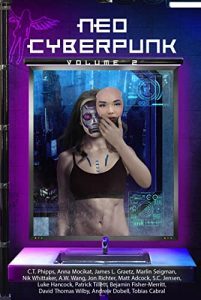 [AM] Neo Cyberpunk II is an anthology book series featuring short stories written by some of the best contemporary cyberpunk authors. It’s the perfect read for cyberpunk fans and readers who experience the genre for the first time alike.
[AM] Neo Cyberpunk II is an anthology book series featuring short stories written by some of the best contemporary cyberpunk authors. It’s the perfect read for cyberpunk fans and readers who experience the genre for the first time alike.
[GdM] Were you involved in the first volume?
[AM] Yes, I created Neo Cyberpunk and functioned as an organizer and editor for both books.
[GdM] What inspired you to create these books?
[AM] I love cyberpunk. For me, it’s the most exciting and innovative sci-fi subgenre. Yet for many people it’s stuck in the 80s and seen as retro-futurism. Some even claim cyberpunk was dead. This couldn’t be further from the truth. Cyberpunk has never been as much alive as it is now, with a new generation of incredible authors exploring this exciting genre in all its diversity. Cyberpunk is so much more than Neuromancer and Snow Crash.
[GdM] How would you describe cyberpunk to readers unfamiliar with the genre?
[AM] Haha, that’s the big question. If you look at social media, you’ll find people arguing endlessly about “What is Cyberpunk?”. One of the reasons I created Neo Cyberpunk is to show how incredibly diverse the genre is. Some works are more action-driven, others are deeply philosophical. Some are funny, others are set in grim, dystopian worlds. Some are set in the near future, in the next 20-40 years, others are set in a future as far away as 300 years or more.
Some are political, others are not. I think what separates cyberpunk from other sci-fi genres is that there are no alien races or intergalactical space travels. Most cyberpunk works is set on earth in relatively realistic, grounded settings. Most are set in urban areas in a world where often mega-corporations have replaced traditional governments. Transhumanism, AI and VR are very important topics in cyberpunk and most works deal at least with one of them, many include all.
[GdM] What appeals to you about cyberpunk?
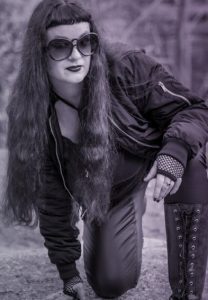 [AM] Personally, I’m a huge fan of cyborgs. My love for them began many years ago when I saw Ghost in the Shell for the first time. The blend of human and machine and the philosophical and psychological questions coming with that fascinate me. It’s something I explore deeply in my own cyberpunk series Behind Blue Eyes. But as a reader, I enjoy all forms of cyberpunk.
[AM] Personally, I’m a huge fan of cyborgs. My love for them began many years ago when I saw Ghost in the Shell for the first time. The blend of human and machine and the philosophical and psychological questions coming with that fascinate me. It’s something I explore deeply in my own cyberpunk series Behind Blue Eyes. But as a reader, I enjoy all forms of cyberpunk.
[GdM] Do you think the cyberpunk genre is alive or dead?
[AM] As stated above, I think it’s more alive than ever. And Neo Cyberpunk is a great proof of that.
[GdM] Can you describe what your story is like inside the anthology?
[AM] My story The Heavenly Hunting Grounds is set in the Behind Blue Eyes universe and features one of the most popular characters of the series, Adriel, in a guest appearance. A woman wakes up in a strange place and soon finds out that she and hundred other people have been abducted to be used as game for members of the elite, who pay a lot of money to go on a “hunting party”. It’s all fun and giggles until a real apex predator descends on the wannabe hunters… The story is connected to Behind Blue Eyes: Fallen Angels but can be read as a stand-alone and enjoyed by readers who don’t know my books yet.
[GdM] What are some other stories that you think readers will like?
[AM] I handpicked all stories featured in the book and functioned as a beta reader for all authors, so I’m very proud to say that I think all of them are fantastic. I think there’s something in the book for every taste. Two stories are comedic, some are action-driven, and some are violent and very dark. It’s a unique blend.
[GdM] Do you have a favorite of the stories?
[AM] I do! I think the star among the stories in Neo Cyberpunk Volume 2 is Technoviking by Benjamin Fisher-Merritt. It’s about a man and his axe against a high-tech army, lol. It’s a great story and the character is a bit like a cyberpunk version of the Witcher. I’ve encouraged the author to make a novel out of the story and I think it’s going to be amazing! I mean, who doesn’t love a man and his axe fighting high-tech soldiers?
[GdM] How did you assemble so many authors for your anthology?
[AM] I’m as introverted as any author but I’m also very good at building networks and communities. I have created several groups for cyberpunk authors on Facebook, Twitter, and Discord, where authors can meet, exchange ideas and help each other out. Our genre is a small niche and I firmly believe that teamwork is the key to success for everyone.
That being said, I know a huge amount of very talented authors. The anthology could have featured many more stories by talented authors, but we wanted to cap it 15. I also would like to point out that, that while the whole thing was my idea, it wasn’t me alone who created the anthology. I could never have done it without my co-editor James L. Graetz and the help of Marlin Seigman and A.W. Wang.
[GdM] What can we expect from you in the future?
[AM] A lot! We’re only getting started with Neo Cyberpunk and hope to establish it as a long-running anthology series and a known brand in the cyberpunk literature scene. Other than that, I have my own books, of course. Behind Blue Eyes 3 will launch in March and I’m very excited about that. Besides this, I have two more series running and am about to launch a new one together with my friend and fellow cyberpunk author C.T. Phipps. When do I sleep, you ask? I don’t! I’m a cyborg after all.
Read Neo Cyberpunk Volume 2
The post Speaking with Anna Mocikat about Neo Cyberpunk Volume 2 appeared first on Grimdark Magazine.
January 16, 2022
REVIEW: Snowpiercer The Prequel: Extinction by Matz, Jean-Marc Rochette
I very much enjoyed the Snowpiercer movie, and thus when I saw at the library there was a three-part series of graphic novels called Snowpiercer The Prequel: Extinction to go along with the brilliant film, I was stoked. If you aren’t familiar with the film, it is about a future society that travels around on a train. The rest of the world is a snowy wasteland, but the last remnants of the world are divided by class on this gigantic train. We don’t know why the train is the only viable escape route for humanity, but it just is. Snowpiercer is a story that requires a lot of suspension of disbelief.
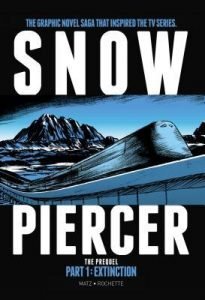 Writing in this story is both its strength and a weakness. The writing is tight and exciting. The dialog is concise and engaging; the problem is that it is so heavy-handed and overwrought. I found myself confused and shaking my head. There is such a thing as subtlety in writing, not every idea needs to be pounded into the reader’s head like a nail into a piece of wood. This story doesn’t quite get that.
Writing in this story is both its strength and a weakness. The writing is tight and exciting. The dialog is concise and engaging; the problem is that it is so heavy-handed and overwrought. I found myself confused and shaking my head. There is such a thing as subtlety in writing, not every idea needs to be pounded into the reader’s head like a nail into a piece of wood. This story doesn’t quite get that.
Art-wise, it is done beautifully. But you have to like this type of artwork. The shading is quite stark and dramatic, which, on the one hand, adds to the drama of the story. But, on the other hand, it could be distracting and again overwrought to the reader.
If you are a fan of the Snowpiercer series, I say check out this book even if it is for a sense of completion. However, I would not go out of my way to read this.
Read Snowpiercer The Prequel: Extinction by Matz, Jean-Marc Rochette
The post REVIEW: Snowpiercer The Prequel: Extinction by Matz, Jean-Marc Rochette appeared first on Grimdark Magazine.
REVIEW: The Witcher Season 2 Episode 8: Family
And now we come to the end of season 2 with episode 8, Family. Voleth Meir, the Deathless Mother, has possessed Ciri. Luckily, there’s no retread of the Eskel plotline where the Witchers are unaware of the possession. She kills a few in their sleep, and then they’re onto her.
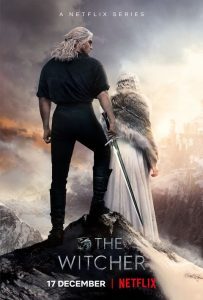 Ciri is trapped within her own memories, but the memories are pleasant ones, keeping her distracted so she doesn’t try to force her way out. She sees a chance to redo the events of the first episode, where she keeps her grandmother Queen Calanthe waiting, but everything is brighter and more vibrant than it was in that episode, a nice use of colour and lighting.
Ciri is trapped within her own memories, but the memories are pleasant ones, keeping her distracted so she doesn’t try to force her way out. She sees a chance to redo the events of the first episode, where she keeps her grandmother Queen Calanthe waiting, but everything is brighter and more vibrant than it was in that episode, a nice use of colour and lighting.
Geralt tries to bargain with Voleth Meir to take him instead of Ciri. I understand the impulse, but given the ever-growing list of people trying to get or kill Ciri, and the amount of power she wields without understanding, Voleth Meir had no real reason to even consider it.
She shrieks and breaks open the medallion tree, which has a monolith inside it, and from it burst forth several basilisks for the Witchers to fight. The hidden monolith is another one of those things about The Witcher that ignores logic in favour of drama. This is just a risk: everyone’s suspension of disbelief will come at a different time.
I also wondered, during this fight scene, where Yarpin Zigrin and his dwarves vanished to. They were supposed to deliver Ciri to Kaer Morhen, and they did so between the end of episode 7 and the beginning of episode 8. They would have been both useful and interesting as a separate faction in Kaer Morhen. In a season as serialized as this had been, it seems odd to drop such a plot point that was only introduced in episode 7, and wasn’t strictly needed there either.
The battle with the basilisks goes badly for the Witchers, and it draws even more ire out of Vesemir. The show hints at a Vesemir-Geralt battle, as both try to protect their wards. It sidesteps it instead, by forcing Geralt out of the scene via basilisk, and when Vesemir does go to hurt the possessed Ciri, she heals almost instantly. Ergo, there’s no need for that battle—a different tactic is clearly necessary.
[image error]Geralt and the other Witchers realize—with an assist from Jaskier and Yennefer—that they need to remind Ciri of the importance of being a part of their world, rather than the imagined, utopian one Voleth Meir has placed into her mind. This isn’t quite enough, and Yennefer, who knows she feeds on pain, cuts her wrists to draw Voleth Meir out. This is her atonement and sincerely, a fantastic capstone for Yennefer’s arc this season.
The epilogue to this episode is quite long, going between the various factions and showing what their plans are going forward, and each one of them seems to be some variation of ‘capture or kill Cirilla.’
So that’s it for The Witcher Season 2. Some great moments, some head-scratchers, some amazing monster design (The Bruxa! The Leshi!) several solid action sequences and two all-time-great ones. I’m looking forward to season 3, even as I know I won’t be getting the monster of the week I’d like.
The post REVIEW: The Witcher Season 2 Episode 8: Family appeared first on Grimdark Magazine.
January 15, 2022
REVIEW: The Harrowing of Doom by David Annandale
Despite being the first entry (of 4, as of this writing) in the prose novel series Marvel Untold, David Annandale’s The Harrowing of Doom is the last entry I’ve read. I discovered the series when I reviewed The Patriot List by David Guymer , which I quite enjoyed. While I couldn’t get into the third book, Witches Unleashed, I read, reviewed and enjoyed the fourth book, Reign of the Devourer. The Patriot List and Witches Unleashed were both stand alone novels. Reign of the Devourer, also by David Annandale, was a direct sequel to The Harrowing of Doom, and having enjoyed Reign I was excited to come full circle. It was the right choice because The Harrowing of Doom is the best book in a good series.
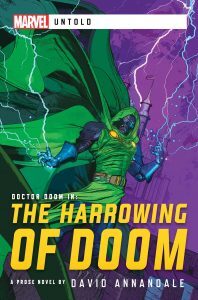 Doctor Victor Von Doom, known in his country Latveria simply as Doom, fights a duel against the forces of Hell every year to try to free the soul of his mother. Every year Doom fails. That is, until he has the idea to join forces with the most powerful witch in his land, Maria Von Helm. Together they will construct a machine built from super science and sorcery: the Harrower. Meanwhile, Rudolfo Fortunov, former crown prince and now leader of the royalist underground, plots to overthrow Doom and seize control of Latveria. Threads of dark magic, betrayal, rebellion and tragedy come together to tell a truly riveting tale.
Doctor Victor Von Doom, known in his country Latveria simply as Doom, fights a duel against the forces of Hell every year to try to free the soul of his mother. Every year Doom fails. That is, until he has the idea to join forces with the most powerful witch in his land, Maria Von Helm. Together they will construct a machine built from super science and sorcery: the Harrower. Meanwhile, Rudolfo Fortunov, former crown prince and now leader of the royalist underground, plots to overthrow Doom and seize control of Latveria. Threads of dark magic, betrayal, rebellion and tragedy come together to tell a truly riveting tale.
The Harrowing of Doom is a quick read and a real page turner. It’s not often a book keeps me up late so I can read just one more chapter, but The Harrowing of Doom got its hooks in me. Annandale’s prose is straight forward and doesn’t get bogged down in unnecessary detail or exposition. While a key element of Doom’s character is his indomitable will, I will say that Annandale harped on the point once too often, but that’s a minor complaint. I also found Zargo’s character a bit one note, his transition from student of mysticism to priesthood a bit of a hole. Otherwise, Annandale does a fine job breathing life into his characters in a short amount of space. My chief complaint about the Marvel Untold novels is that since they’re tie in novels, I don’t worry as much about the main characters. The Harrowing of Doom managed to suspend my disbelief a few times, and I found myself concerned for the safety of certain characters in spite of myself.
The novel is well paced, dialogue is well written, and the action scenes are exciting. But for me, The Harrowing of Doom’s best qualities are its horror elements. There were several passages in particular where his depiction of Hell was terrifying in a very classical way, reminding me of Edgar Allan Poe and early Black Sabbath albums. Not gruesome or gory, but still evoking otherworldliness and dread as our reality faded away and was replaced by a literal Hellscape. These scenes were highlights of the book and are what elevates The Harrowing of Doom above the rest of the Marvel Untold series. The Harrowing of Doom is a good read and highly recommended for fans of the darker side of comics or anyone who’s looking for a sampler of action and super science with delightful splashes of gothic horror.
Read The Harrowing of Doom by David Annandale
The post REVIEW: The Harrowing of Doom by David Annandale appeared first on Grimdark Magazine.
January 14, 2022
REVIEW: When Gravity Fails by George Alec Effinger
When Gravity Fails by George Alec Effinger is a classic novel of cyberpunk and one of the foundational texts of the genre. Whenever you think of the word cyberpunk and imagine a gritty neon landscape of crime, sex, drugs, and cyberware then you might be thinking of Neuromancer, but you also might be thinking of the Budayeen. Or, if you’re not, then you might want to check out this book because it’s so fantastically written. Not all of it has aged well in the years since its release in 1986 but some of it was way ahead of its time.
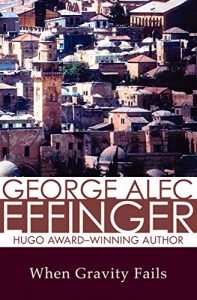 The premise is that the Soviet Union and America have both fallen in the wake of the Cold War, not due to nuclear war but economic collapse. In the aftermath, the Middle East and Europe have risen to fill the cultural gap. In a nameless city in the Levant, probably Damascus, the Red Light district is known as the Budayeen. Every vice imaginable is catered for to customers, including the opportunity to use “Moddies” and “Daddies” to upload to your brain.
The premise is that the Soviet Union and America have both fallen in the wake of the Cold War, not due to nuclear war but economic collapse. In the aftermath, the Middle East and Europe have risen to fill the cultural gap. In a nameless city in the Levant, probably Damascus, the Red Light district is known as the Budayeen. Every vice imaginable is catered for to customers, including the opportunity to use “Moddies” and “Daddies” to upload to your brain.
Moddies will give you skills like the Matrix be they kung fu, different languages, or an understanding of European history. They will also vanish the moment you pop out the disk. Daddies are more insidious in that they give you an entirely new personality. You can be anyone from James Bond to Jesus. I like this kind of exploration of hypothetical technologies.
Living in the Budayeen is Marid Audran, a small-time grifter who is enjoying life as a man independent of the larger criminal underworld ruled by “Papa” Friedlander Bey. He is presently hooked up with a sex worker named Yasmin (one of the many trans characters in the book) and seems to have a handle on things. Well, except for the fact he’s a drug addict and terrified of being cybernetically upgraded. Either way, he thinks of himself as independent, and this gets him involved in two cases that summarily end with his clients horribly murdered. From there, his life goes on a steady downward slope that gets him involved in international intrigue as well as dealing with a serial killer.
When Gravity Fails is the kind of filthy, gritty, neo-noir cyberpunk that I am fond of. It is steeped in sex, violence, and moral ambiguity with no one remotely clean. Marid Audran is a classical antihero who must be dragged kicking and screaming into the plot because he’d rather not risk his life even to avenge the death of a friend. This is exactly the kind of adult science fiction that fans of this magazine’s genre would find themselves loving. I also really liked the fact George Alec Effinger chose not to make this a world of “Asia takes over the world” like so much cyberpunk but went down the road less travelled.
The Budayeen is an incredibly well-realized location and it’s obvious that the author drew from his own experiences in New Orleans’ French Quarter and many stories from there to help flesh out the fantastic collection of characters therein. They’re the kind of oddball eccentric cast that sticks in your mind yet never seems unbelievable. No one is particularly likable, being a dangerous collection of thugs as well as con men, but no one is boring. This is certainly the kind of place you’d want to visit if not stay, assuming you had enough money to burn.
I also feel like the author’s research into Arabic culture is shown, highlighting both minutia as well as well-life compromises with both religion as well as taboo. Marid is not a devout Muslim but deals with many others who range from fundamentalists to hypocrites to genuinely faithful. Which is a very roundabout way of saying that it doesn’t just feel like the Western world dumped into an exotic location either, 70s New Orleans influences or not. It’s more than just a sleazy R-rated cyberpunk Casablanca but you could do that story here too.
There’s some issues that should be brought up for anyone who wants to dive into the seedy world of the Budayeen. Violence is horrifying, sexual assaults occur [off camera], and the handling of certain identity issues is not entirely accurate. George Alec Effinger was a progressive and included many trans characters in his works but most of them are sex workers as well as not quite having a modern idea of the psychology involved in gender transitioning (it was the 80s). Marid also uses quite a number of self-deprecating racial slurs about himself that may put off other readers.
However, if this is something you’re willing to overlook or consider it part of the world-building then this is a hearty recommendation. It is also followed up by two sequels. It’s a shame George Alec Effinger died before he could finish his fourth book in the series. Few people seem capable of making a world like this leap off the page as he did.
Read When Gravity Fails by George Alec Effinger
The post REVIEW: When Gravity Fails by George Alec Effinger appeared first on Grimdark Magazine.
REVIEW: The Expanse S6 E4: Redoubt
Redoubt is the first episode of The Expanse season six where I think the show has had a serious misfire because with only six episodes in the season, you’d expect them to be firing on all cylinders. Instead, the story feels almost like a clip show as everyone spends the episode discussing the events of the previous episode. The problem was that the previous episode didn’t actually have that much happen.
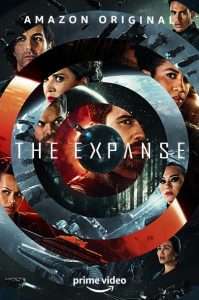 In the previous episode, Marcos Inaros (Keon Alexander) was almost killed by Holden and the Rocinante. The plucky heroes of the ship managed to come within inches of ending the biggest mass murderer of all time. Unfortunately, Holden pulled back at the last second and disabled the missile that would have killed Inaros but also Naomi’s son Fillip.
In the previous episode, Marcos Inaros (Keon Alexander) was almost killed by Holden and the Rocinante. The plucky heroes of the ship managed to come within inches of ending the biggest mass murderer of all time. Unfortunately, Holden pulled back at the last second and disabled the missile that would have killed Inaros but also Naomi’s son Fillip.
Needless to say, a lot of the Rocinante crew is less than pleased that Holden (Steven Strait) chose to potentially let the end of the war slip through their grasp. Even Naomi (Dominque Tipper), the person who Holden did this for, isn’t grateful because defeating Inaros is something she intellectually knows is more important than her son’s life. As she tells Holden, he’s put every life that Inaros takes on her shoulders whether he wants to or not.
Drummer (Cara Gee) continues to try to undermine the Free Navy and build up a coalition of Belters who hate what he stands for. Inaros benefits from the fact that all of his actions seems to be against the Inners (Earth and Mars) so that no matter how heinous, they will always look like those of a freedom fighter to certain groups. Fighting against his own people, though, will undermine everything that he stands for.
Her speech to Inaros is something that almost justifies the existence of the episode by itself as we see that he is a weak and cowardly man who isn’t the epic leader he’s set himself up to be. Indeed, Drummer is the kind of leader the Belters need and would have been if Fred Johnson had turned power over to her or another Belter earlier in his carer. This is a big change from the book but the series has done well in giving the actress much more to do.
We continue to get material about life on Laconia and the weird protomolecule technology present there, setting up something similar to Pet Semetary. We also get to finally meet the absolute dictator of Laconia in Duarte. I’m increasingly of the mind the Expanse will not end at the end of this season but perhaps be continued in television movies or some other medium.
In conclusion, with only two episodes to go, this episode felt extremely padded and suffered for it. We really should have been exploring the characters more and the events around Inaros’ Free Navy but it seems like we’re just killing time until the end.
The post REVIEW: The Expanse S6 E4: Redoubt appeared first on Grimdark Magazine.
January 13, 2022
REVIEW: Legacy of Ghosts by Alicia Wanstall-Burke
Lidan and Ranoth dramatically return in Legacy of Ghosts, the second installment of the Coraidic Sagas trilogy. Four years has passed since the events in Blood of Heirs with Lidan and Ran’s worst fears nearing fruition. They must make crucial and life altering decisions. They will face more powerful enemies and fouler magic. At last, the fates of Alicia Wanstall-Burke’s beloved characters collide.
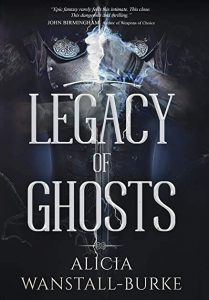 Despite the time jump from the first book, Legacy of Ghosts is a familiar return to the lives of Lidan and Ran. Ranoth Olseta remains a fugitive from his father, the duke of Orthia. While Ran is learning to accept and control his powers, his father’s intolerance for magic has only escalated with time. The keep that once provided solace to Ran and other magic users is no longer safe. For the first time in four years, Ran must venture across unknown lands. As first daughter to Daari Erlon, Lidan Tolak’s right to the throne is now strongly contested with the birth of her brother. As she struggles with the conflicting expectations set by her parents, she must ultimately choose between what her heart desires or her integrity.
Despite the time jump from the first book, Legacy of Ghosts is a familiar return to the lives of Lidan and Ran. Ranoth Olseta remains a fugitive from his father, the duke of Orthia. While Ran is learning to accept and control his powers, his father’s intolerance for magic has only escalated with time. The keep that once provided solace to Ran and other magic users is no longer safe. For the first time in four years, Ran must venture across unknown lands. As first daughter to Daari Erlon, Lidan Tolak’s right to the throne is now strongly contested with the birth of her brother. As she struggles with the conflicting expectations set by her parents, she must ultimately choose between what her heart desires or her integrity.
Legacy of Ghosts is about the personal journeys of Ran and Lidan. Wanstall-Burke honored her maturing characters by intensifying their character arcs and intimate relationship dynamics. Compared to its predecessor, book two focuses more on the damaging effects of trauma. In the throes of loss, the bonds between friends and family become a focal point. I was delighted to learn more about Ran’s ghost companion and Lidan’s siblings.
While creatures such as the Ngaru continue to roam the lands, human enemies pose the real threat. It is time for the kingdoms to swear new loyalties and strengthen allegiances. In Legacy of Ghosts, new oaths will forge and be broken. Our characters learn that no bond is safe from treachery.
Wanstall-Burke amplified the action in Legacy of Ghosts. Between the political battles, we are introduced to new monsters and frightening curses. While there are plenty of visually stunning scenes and character growth throughout, the plot felt concentrated to the last quarter of the book. The ending left me all too eager for book three.
Legacy of Ghosts is a strong successor for the Coraidic Sagas trilogy. Wanstall-Burke held no reservations in challenging her characters. The battles are amplified. The risks are higher. The choices Ran and Lidan make will forever impact the lives of those they love.
Read Legacy of Ghosts by Alicia Wanstall-Burke
The post REVIEW: Legacy of Ghosts by Alicia Wanstall-Burke appeared first on Grimdark Magazine.
Review: The Witcher Season 2 Episode 7: Voleth Meir
Voleth Meir is an entirely new character to the Witcher setting, not featured in the books or the games. Voleth Meir was a solid addition, a Baba Yaga-esque manipulating witch-goddess bound to a hut by the first witchers. She’s been manipulating everything all season, and we’re finally on our way to that confrontation.
 Voleth Meir gave the elves their first pure-blood elf in a long time, and it gave Fringilla power, and then it took both away through the same event. The birth of the child makes the elves less willing to fight on behalf of Cintra; they’d rather rebuild, which puts Cintra and the elves back against each other.
Voleth Meir gave the elves their first pure-blood elf in a long time, and it gave Fringilla power, and then it took both away through the same event. The birth of the child makes the elves less willing to fight on behalf of Cintra; they’d rather rebuild, which puts Cintra and the elves back against each other.
We start with Jaskier having an amusing sequence in jail, absolutely tormenting his captor with his incessant singing, as well as having befriended the mice. Typical Jaskier stuff. Geralt comes in to rescue him. Yennefer had mentioned meeting him before she took Ciri and fled, so he’s come to get what information he can.
Jaskier reminds Geralt that he’d left him on a mountainside the last they’d spoken, and is still irritated, but gives up that anger for a fairly quick reconciliation. This is for the best, as keeping Jaskier and Geralt apart does nothing for the show.
Their travel also includes running into Yarpen Zigrin, last seen in Season 1, Episode 5, and his band of stab-happy dwarves, who join them on a mission Geralt won’t tell them about.
Yennefer and Ciri meanwhile keep fleeing, and Yennefer convinces Ciri that Geralt is likely a captive of Cintra. Ciri still believes Yennefer is trying to keep her safe and follows along. Yennefer dodges most questions or answers in half-truths, but saying Geralt is likely captured and in Cintra is a full-throated lie, intended to get Ciri to the shattered door so Yennefer can make her trade with Voleth Meir and get her magic back.
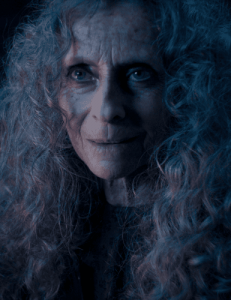 When they finally reach it, Ciri figures it out and Yennefer tells her she can flee. Yennefer can’t, but she can suggest that Ciri run away. Instead, Ciri screams and her uncontrollable magic breaks the ground all the way to Cintra, which alerts some guards who come after them. Geralt also shows up to rescue Ciri. The convergence of the plot-lines—three groups showing up in the same place at the exact same time—feels odd considering Yennefer and Ciri teleported and Geralt and Jaskier did not. That said, The Witcher has always been a show that puts drama over logistics.
When they finally reach it, Ciri figures it out and Yennefer tells her she can flee. Yennefer can’t, but she can suggest that Ciri run away. Instead, Ciri screams and her uncontrollable magic breaks the ground all the way to Cintra, which alerts some guards who come after them. Geralt also shows up to rescue Ciri. The convergence of the plot-lines—three groups showing up in the same place at the exact same time—feels odd considering Yennefer and Ciri teleported and Geralt and Jaskier did not. That said, The Witcher has always been a show that puts drama over logistics.
But that’s a minor nuisance to see Geralt’s fury at Yennefer. His sword lingers at her neck. His growled ‘Mine’ to Yarpin is another example of just how well Cavill understands this character. He sends Ciri away with Jaskier, and Yarpin and his dwarves, without moving his sword from Yennefer’s neck.
He gets her to recite the incantation to get back into Voleth Meir’s hut, only for them to realize that she’s made enough chaos in the world that she can finally manifest in the real world once more.
The post Review: The Witcher Season 2 Episode 7: Voleth Meir appeared first on Grimdark Magazine.



